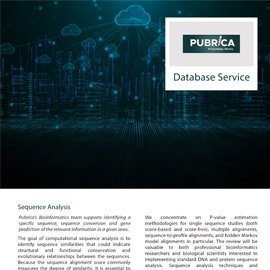Sequence Conversion
Pubrica’s Bioinformatics team supports identifying a specific sequence, sequence conversion and gene prediction of the relevant information in a given area.
During the post-replicative sequence, conversion efficiently transfers genetic information in a high yield. Many researchers have focused on post-genome investigations, such as finding gene functions and modeling interaction networks; gene regulatory networks, signal transduction networks, and metabolic pathway networks, for example, are all examples of networks. Once a sequence has been produced through some biological treatment, the biological analyst attempts to determine its structural, functional, and evolutionary significance by analyzing it to other sequences of interest at the DNA base or amino acid level. A DNA sequence comprises base characters that represent adenine, thymine, guanine, and cytosine, and it encodes genetic information. A codon is a sequence of three nucleotides that can encode an amino acid. Twenty different amino acids correspond to 64 different codons.
The amino acid code for each codon is represented by a single letter. There are three potential reading frames for a DNA sequence in each direction from 5' to 3' and from 3' to 5'. The way nucleotides are read in groups of three to specify a code is called a reading frame. Each reading frame is represented by six amino acid sequences generated by the established system. A sequence of codons called an ORF (open reading frame) begins with an initiation codon (i.e., ATG) and ends with a termination codon for each reading frame (e.g., TAA, TGA, TAG). An ORF is a possible coding region that encodes a gene and is thus used to put together a protein when it is produced. An ORF is used in biology to determine whether its sequence encodes protein composition information by performing homology analysis at the amino acid level or as a yardstick for estimating a coded proteins size or molecular mass. The most extended reading frame with no in-frame stop codons is commonly referred to as a meaningful ORF.
Our comprehensive Bioinformatics Database services
Types of Bioinformatics: We undertake different types of Sequence conversion for dot-matrix methods, dot plot methods and dynamic programming research work.
Wide range of Sources: NCBI, BLAST, Pubmed, Pubmed Nucleotide, Pubmed Protein, Pubmed Gene, Pubmed Sequence.
Let experts support you’re Bioinformatics Research.
We’ll scale
up as your needs grow.
No compromising on integrity and quality. Our processes are well defined and flexible to ramp up as per your requirements.
Partnering with
you till the project end.
We come with you all the way. From design to market support

Pubrica Offerings
Pubrica provides comprehensive bioinformatics research work publishing assistance for various publications, journals, and books. With our writing services, you can now turn your ideas into Project writing, Proposal writing, Research Writing, Thesis writing and Manuscript writing. Science, Technology, Engineering, and Mathematics (STEM) experts with a therapeutic background. It is now simple to publish a research work or obtain regulatory drug approval. With Pubrica's help, you can save time and money.
Frequently asked questions
We are with you the whole nine yards. In this section, we answer the tough questions. For any information, contact us via +91-9884350006 meanwhile, here are some of those queries
A biological database is a well-organized collection of persistent data typically enhanced by biologically relevant data, such as genomic sequences of a rapidly increasing number of organisms.
Biological databases can retrieve structures, binding locations, metabolic connections, molecular action, functional correlations, protein families, motifs, and homologous sequences. A biological databases main objective is to store and manage biological data and information in computer-readable formats.
Archieval databases are also known as primary databases. They are filled with data produced from experiments, such as nucleotide sequences, protein sequences, and macromolecular structures. Researchers enter experimental results directly into the database, and the data is virtually archival.
Bioinformatics tools aid in the comparison, analysis, and interpretation of genetic and genomic data, as well as the comprehension of molecular biology evolutionary aspects in general. It aids in researching and categorizing biological pathways and networks that are essential parts of systems biology more integrated..
A sequence database is a sort of biological database made up of an infinite collection of computerized ("digital") nucleic acid sequences, protein sequences, or other polymer sequences maintained on a computer in the field of bioinformatics. A protein sequence database such as the UniProt database is an example.


